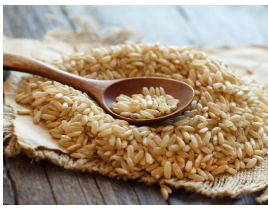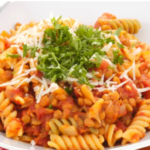Among the varieties of brown rice, Yamani rice occupies a very special place due to its nutritional value and how easy it is to digest for the body. With a smooth texture and a slightly sweet flavor, this cereal is one of the favorites for those who opt for an organic diet.
 Gluten-free, hypoallergenic and full of fiber, this rice is a delicious source of energy that you can’t stop trying. Today we tell you about the properties that have earned it the position of the healthiest of all so that you can make the most of this jewel of Asian cuisine. If you want to learn how to cook Yamani rice, we tell you how to do it so that you can combine it with vegetables or meat.
Gluten-free, hypoallergenic and full of fiber, this rice is a delicious source of energy that you can’t stop trying. Today we tell you about the properties that have earned it the position of the healthiest of all so that you can make the most of this jewel of Asian cuisine. If you want to learn how to cook Yamani rice, we tell you how to do it so that you can combine it with vegetables or meat.
What is Yamani rice?
Yamani rice is a type of brown rice whose grain is golden, short and resistant. It grows in temperate climates and is consumed especially in Asian countries. Unlike white or processed rice, brown rice is purer, as it retains its bran or husk, where most of its nutrients are reserved.
Of Japanese origin, it is considered by the Orientals as a grain of perfect balance. They use it in many of their meals and it is especially known for its slightly nutty flavor. Yamani rice can be kept for months as long as you seal it hermetically and store it in dry places.
How to cook cooked Yamani rice?
Preparing white Yamani rice is quick and easy. It does not require many more steps than what you need to cook white rice and the benefits that we can obtain can be healthier. This is what you will need to start trying the best recipes with Yamani rice:
Ingredients
- 1 cup Yamani rice
- 2 and a half cups of water
- 1 pinch of salt
Preparation
- Place the rice in a bowl of fresh water and stir gently for a minute to get rid of any grime.
- Drain it with a colander and then open the tap and let the water run over the rice, stirring it for a few minutes.
- Now, put the rice in the pot, add the water and salt. Stir and make sure the level of the rice is even, shake the pot a little bit until there are no places where the rice is higher.
- Cover the pot and raise the heat to the maximum until it boils.
- After boiling, lower the flame and let it cook for about 40 minutes.
- After the time has elapsed, raise the temperature to the maximum for one more minute and remove the pot from the heat.
- Leave the lid on the pot so the rice remains for another 12 minutes and serve.
Tip: It is advisable to use stainless steel, clay or porcelain pots. Avoid aluminum ones, as they can alter the properties of the rice.
Yamani rice cooking time
Of the different varieties of rice, Yamani is one of those that requires more minutes of cooking. It is important to respect the time so that the dishes are perfect. Depending on the method we choose to cook it, times will vary slightly.
Yamani rice cooking in a pressure cooker
In this case, cover the pot and cook over medium-high heat until it beeps. Then lower the flame and place a heat diffuser to prevent it from burning. Cook for about 45 minutes and let it rest for 10 until the pressure is relieved.
Yamani rice cooking in a stainless steel pot
Cooking in stainless steel pot is a little longer. You can also add a heat diffuser and cover the pot once the water boils. Cook for 50 minutes without stirring and let stand for 15 more minutes.
Yamani rice cooking in the microwave
If you want to cook Yamani rice in the microwave, remember to use a container suitable for cooking. Cook for 12 minutes at maximum power or at 780W. Do not completely cover the pot so that the steam has room to escape. After the first 12 minutes are up, take it out of the microwave and stir it with a spoon. Put it back in and let it cook for another 10 or 12 minutes. Allow it to rest for a few minutes after finishing and it will be ready to serve.
Tip: If you want to make more rice, just add 3 ¾ cups of water for 2 rice, and 5 ½ cups of water for 3 rice.
Yamani rice properties
Being a whole husk grain, one of the main properties of Yamani rice is that it preserves the nutrients that are otherwise lost in other types of rice without husks. The absence of gluten makes it ideal for coeliac and its exquisite flavor allows us to enjoy it alone or combined with other recipes.
On the other hand, in addition to providing a high intake of carbohydrates, it has a high fiber content, which helps normalize blood sugar levels and fats. Therefore, its consumption is recommended for those who suffer from diabetes. Also, people who follow a macrobiotic diet choose this type of rice for its balanced ph. Also, thanks to the type of starch it contains, Yamani rice feels very good in our stomach and liver.
Among the nutritional properties that Yamani rice gives us, there is a wide range of B vitamins, beneficial for the nervous and intestinal systems. If we consume it constantly, we can access a portion rich in fiber and minerals such as potassium, magnesium, phosphorus and calcium.
Yamani rice benefits
Yamani rice is one of the healthiest among the different varieties of brown rice. People suffering from heart or kidney conditions consume this rice for its hypotensive characteristics. In addition, it contains physic acid that helps expel toxins from the body.
Thanks to the fact that it maintains a large part of its bran or shell [1], it preserves many of the minerals and vitamins necessary for the balance of our body. So it’s no wondering some Asians use it in so many of their dishes!
Is Yamani rice fattening?
Every 100 grams of Yamani rice provides us with about 350 Kcal and 7.4 grams of protein. However, one of the qualities of this type of rice is that it produces a rapid feeling of satiety in our body, so we will not feel the need to eat more than necessary.
Moreover, it is digested very easily and slowly. It is a rich source of energy that helps us maintain enough strength to carry out our daily activities. For all this, Yamani rice is not considered fattening, and instead, it is admired for how healthy it is for our body.
However, it is important to remember that Yamani rice has almost as many calories as white rice. Therefore, be careful not to eat too much and vary the cereals you use.
If you want to know more about the nutritional values of different types of rice, you can take a look at our article “Is rice fattening or slimming?”
Recipes with Yamani rice
If Yamani rice has something, it is an immense potential to try it with many recipes and continue taking advantage of all its properties. Whether with meat or vegetables, this type of rice combines perfectly with a wide variety of ingredients. If you want to start experimenting with recipes with Yamani rice, we suggest some of them.
1. Yamani rice burger
There are many ways to prepare vegetarian burgers and these Yamani rice burgers with oats and vegetables are a delicious option that you will surely want to repeat.
Ingredients
- 1 cup of cooked Yamani rice.
- ½ cup of whole meal flour.
- Vegetables to taste such as carrots, onions, peppers, among others.
- 1-2 eggs.
- ½ cup of oatmeal.
- Seasonings to taste.
Preparation
- Place the cooked Yamani rice in a bowl and mix it with the grated or chopped vegetables.
- Add the grated cheese, eggs and seasonings, and stir.
- Little by little, integrate the whole meal flour and oatmeal, until there is a mixture that you can easily knead.
- Shape the burgers and cook them in the oven at 200 degrees Celsius for about 20 minutes.
- Remember to turn them over halfway through cooking and serving.
2. Wok of Yamani rice, chicken and vegetables
The wok is one of the most iconic dishes in East Asian cuisine. This time we change the noodles for Yamani rice and add chicken and vegetables. If you want, you can make a vegetarian option without chicken.
Ingredients
- 1 carrot
- 1 onion.
- 1 zucchini
- ¼ red bell pepper.
- 2 scrambled eggs.
- Yamani rice.
- 1 piece of chicken cut into squares.
- 1 tablespoon of soy sauce.
- Olive oil.
- Vegetable soup.
Preparation
- Cook the Yamani rice with the vegetable broth or chicken broth and let it rest.
- Fry the chopped vegetables in very small pieces in olive oil and stir them. They should be left with a crunchy texture.
- Cut the chicken and add it to the pan with the vegetables. Add salt and a little brother. Mix and wait for it to finish cooking.
- Meanwhile, prepare the scrambled eggs in another pan, whisk them together and add salt and pepper to taste.
- After checking that the chicken is cooked, add the rice and scrambled eggs, mix. Turn on the fire so that they all heat up together and they will be ready to serve.



